Texts: Dr. Peter Dittmar und zitierte Autor:innen
Introduction: Stephanie Schneider
During the period of the lockdown and the subsequent restrictions on contact, the Berlin galleries chose different ways to stay in touch with art lovers. Dr. Peter Dittmar from the Dittmar Gallery decided on the ” Image of the Week”. For almost three months, he sent an image of a work from his gallery program by e-mail once a week. Each work was accompanied by a short text, which Peter Dittmar wrote individually. “The short texts had to be carefully considered; the pictures, as beautiful as they are, should not be left alone,” Peter Dittmar, who has been a gallery owner for 30 years, explains his idea. “The texts should avoid jargon and cloudy speech, be clear and at the same time differentiated and come to a core statement, as well as the quotes interspersed from case to case. There was no scheme, each text had to be created individually in this compressed form.”
In this way, Peter Dittmar succeeds in turning the contemplation of a single work – accompanied by the compressed but nevertheless narrative and informative texts – into a form of encounter. An encounter not only with art, but also with the person who represents and communicates art. In addition to his detailed knowledge of art history, Dittmar also demonstrates the necessary sensitivity in the field of “explaining” works. Admittedly, the virtual viewing of art cannot replace the physical seeing and experiencing of art in the gallery. It is not for nothing that Dittmar concludes his series with the quote: “You can’t really understand most galleries without visiting their physical spaces”. But this form of approach to a work can complement real viewing, deepen our understanding of it and intensify our relationship to it. With this article we would like to share this encounter with you.
———
8 April 2020
Image of the week: Hana Usui, August 1945

The works of the Japanese artist Hana Usui, born in Tokyo in 1974, are of great complexity for all their restraint. This applies to the relationship between oil drawing and ink painting (and increasingly also to photography), the combination of the graphic and the painterly, of linear conciseness and spatiality. The resulting wealth of expressive levels also characterizes the critical works that have dominated in recent years. Those on the history of their own country, on Fukushima or Hiroshima, open up a new dimension to the theme by distancing themselves from everything that is as striking as from the merely documentary and never seeing themselves as a political manifesto. Through this distance and the merely insinuative and symbolic nature of the artistic means, they gain, so to speak, a quiet intensity and at the same time remain open to questions. The admonition and appeal, removed from the context of the historically conditioned, thus prove their continuing validity.
23 April 2020
Image of the week: Hannsjörg Voth, Boot aus Stein
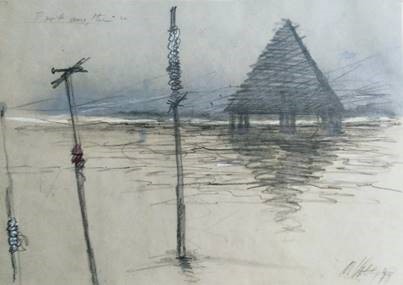
Hannsjörg Voth, born in 1940, has been involved since the early seventies with elaborate projects that are related to the Land Art movement of the time and have attracted worldwide attention in their myth-saturated size. In 1978, the “Journey to the Sea” took place, the cultic journey of a giant mummy on the Rhine, a journey through time, life and death until its destruction. This was immediately followed, in terms of content, by the “Boat of Stone”: in the shallow sea off the Dutch coast, the artist had a twelve-meter-high pyramid built over a pile structure in which he chiselled a boat from a mighty block of dolomite. The work was characterised by its monumental coherence and richest symbolic references, which also revived ancient myths. From the mid-1980s onwards, Voth dedicated himself for two decades to the enormous Land Art projects, the architectural sculptures in the Moroccan desert on the other side of the High Atlas.
The drawings by Voth that accompany the projects take a special place. They are sketches of ideas, construction and architectural drawings, pictorially executed sheets and have an independent work character. The photographs of the artist’s wife, Ingrid Amslinger, also form an essential part of the undertakings; beyond the important function of documentation, they convey an idea of her magic and archaic greatness.
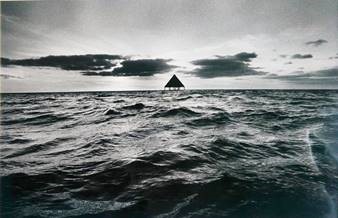
An extensive exhibition on Hannsjörg Voth and Ingrid Amslinger in the Von der Heydt-Museum Wuppertal, which was to open on 24 March 2020, had to be postponed due to circumstances.
30 April 2020
Image of the week: Hideaki Yamanobe, Forest No. 2
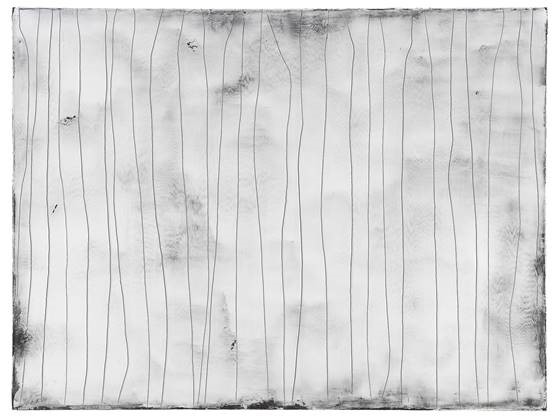
Hideaki Yamanobe, born near Fukushima in 1964 and living in Germany and Japan, is one of the most important artists of the middle generation internationally. Committed to both the Eastern and Western tradition, he quickly found an unmistakable visual expression. The materiality of the works, with their transparent, then again opaque layers of color based on black and white, corresponds in many ways with spatial and atmospheric, landscape references. With sparing means and on the basis of the restriction of colour, which only makes the richness of nuances possible, picture solutions of great urgency are created.
In 2000 and 2002 Yamanobe created the stage design for Helmut Lachenmann’s “Das Mädchen mit den Schwefelhölzer” for performances in Tokyo and at the Salzburg Festival. Among the many exhibitions, special accents were set in 2003 by the Kunsthalle Mannheim, which presents Carl Andre and Yamanobe together in a juxtaposition of important artistic positions, in 2008 by the exhibition in Schloss Morsbroich “Stratus”, in 2013 by the exhibition in the Marburger Kunstverein under the title “The Fullness of Emptiness”.
7 May 2020
Image of the week: Arnulf Rainer
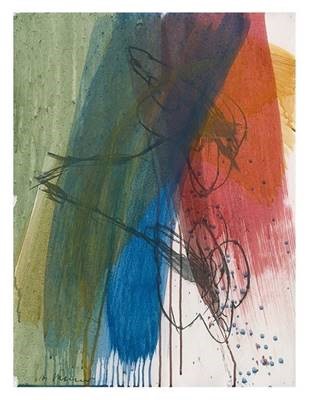
Early on, with the radical overpaintings and crucifixions since the mid-1950s, Arnulf Rainer’s importance for painting in the second half of the 20th century became apparent. His work moves between the poles of monochrome painting, contemplative solutions, and an expressiveness of great intensity. The ability to draw from the fund of these early polar forms of expression, to develop them further and make them newly fertile for other themes remains characteristic of Arnulf Rainer. This saved the work from any flattening and gives it its richness and its continuous tension. Many later works, such as the group of Canary Paintings, are like a synthesis of spontaneous, expressive drawing and the transparent veil of colour that developed from the early Zumalungen. In all of Rainer’s series, the individual sheet is never a variation of the previous one, but an independent individual formulation.
14 May 2020
Image of the week: Mona Breede, Day in Day out
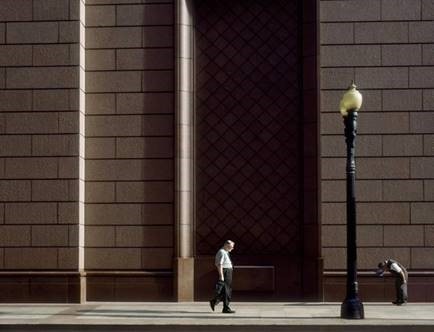
With her atmospherically dense, yet formally strict works, Mona Breede gained an independent position within contemporary photography. She shows people in relation to urban space, including the landscape. In doing so, she developed a view of the people, of their posture, movement, interactions, which unfolds its own aesthetic and compositional stringency and can be described as choreographic. The architectures form the foil for the people, but at the same time bind them into a social context. References to loneliness and social tension take on a sign character, are presented almost emblematically and give the depictions a symbolic power. However, the feeling for the reality of urban spaces and the choreographic moment is always preserved.
21 May 2020
Image of the week: Marcel Gähler
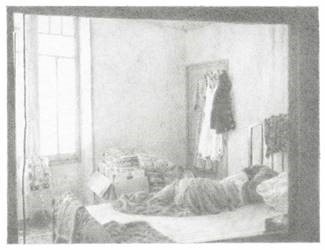
The process of the Swiss artist Marcel Gähler, which is initially to be understood as documentary, comprises various levels of meaning and expression. This refers first of all to the relationship to photography (the photographs are taken from the artist’s personal environment) and the way in which this is made available to a certain experience of the world and artistic transformation in the medium of drawing. The elaborate working method includes several intermediate stages, at the end of which the graphite drawing is created. The artist gains extraordinary possibilities in the reproduction of reality, which he has already conveyed himself, whereby the attention to detail does not become independent. The continuum of the dense line structure, the grey tones and gradations leads to a homogeneous pictorial appearance and constitutes a complex pictorial reality of its own.
“The monochrome tonality and the special framing as a projection surface placed at an angle to the image carrier address, so to speak, the core of what characterizes memory: namely, transience and transitoriness. For the rejuvenation of the image field creates the impression that the image immediately detaches itself again … as if only a bright moment shone out of the darkness.” (Kathleen Bühler, Museum of Fine Arts Bern)
28 May 2020
Image of the week: Sharka Hyland
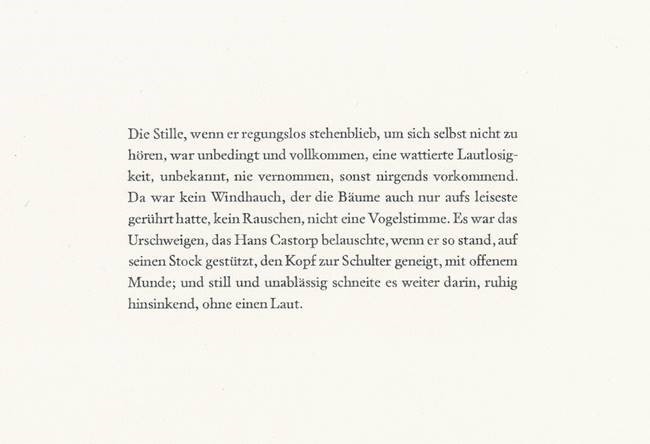
“Sharka Hyland confronts us not only with a new interpretation of what a drawing is, but also with one of the narrative. Most of us use some kind of narrative when we create or view a work of art. What if the narrative, as it is and unchanged, even the text itself, is the work of art?
Sharka Hyland shows graphite drawings of text passages taken from important narrative literature or poetry. We all associate a work of art with a pictorial idea. Sharka Hyland challenges this expectation by providing us with a perfect image that is only written, the image of a text. The texts she selects are of high visual quality, and when they are read, the imagination of the reader (the viewer) is strongly affected by them. The artist gives us an image that is devoid of the figurative; it is up to the viewer to create or recreate it in his mind, solely for himself.
Regardless of the considerations regarding this demanding concept, the text images are already captivating through their beautiful graphic form, through their great aesthetic appeal, even if you do not read them. The reproduced text itself, its form and texture, is pure and perfect in its simplicity”. (Sabina Tichindeleanu)
4 June 2020
Image of the week: Rudolf Englert, Ibiza
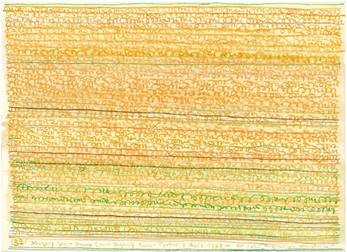
Rudolf Englert (1921-1989) has been developing his formal language since the early sixties, parallel to other similar movements such as ZERO, but largely independently. He produced a series of works in close succession, which were worked out systematically, primarily on paper. The early cycles met with a broad response through exhibitions in leading houses, such as the Kunsthalle Kiel in 1962. According to Will Grohmann in 1964, art criticism emphasized the special position of Englert within the avant-garde currents.
In the seventies, the compositions became more complex and pictorial in layout. The written character as well as the echoes of musical notation, which emerged early, come more clearly to the fore. In Englert’s approach, the fundamentally different approach manifested itself in comparison to the other strategies for writing and writing gesture in the picture. In this way Englert opened up new scope and forms of expression for drawing with his instruments. With his supposedly “easy to grasp and simple means, Englert achieved a manifold complexity, a lightness and density of effect, a sensual seductiveness and inexhaustible fascination”. (Erich Franz)
11 June 2020
Image of the week: Sean Scully, Block
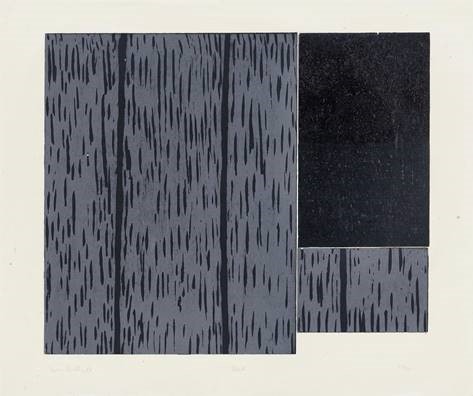
Sean Scully’s last major international exhibitions included those at the Venice Biennales in 2015 and 2019 at Palazzo Falier and in San Giorgio Maggiore, also in 2019 at the Museum für Kunst und Kulturgeschichte in Münster. In Scully’s work, the monumental canvases, the works on paper and the graphic works, each with their specific expressive possibilities based on the same basic vocabulary, stand side by side on an equal footing. “The ambivalent relationships between the color surfaces, which oscillate against each other in ever-recurring constellations, sublimely demonstrate the dialectic of the seemingly always the same. What is decisive in Scully’s work is, on the one hand, the mystery of the choice of colour, in which refracted, multiply modified tones always dominate, and then his ability to create a specific light, which is the inner light of the picture. (Michael Semff, former director of the Graphische Sammlung Munich)
Sean Scully: “The woodcut expands the artistic language; there are wonderful results here in history. It differs from watercolor and pastel as these differ from each other, woodblock and pastel resemble each other in their haptic and sensual qualities. The Japanese paper used for some of my woodblock prints was of a particularly high quality and absorbed the color in the most beautiful way.”
18 June 2020
Image of the week: Gottfried Salzmann
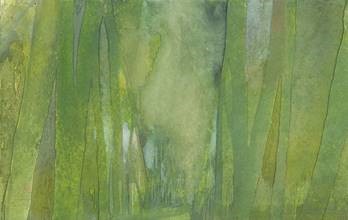
Gottfried Salzmann, born near Salzburg in 1943 and living in France since 1965, gained early recognition with his landscape paintings, watercolors and drawings. In 1982, the great monograph by Walter Koschatzky, the then director of the Albertina in Vienna, was published, as was Wieland Schmied’s monograph on the drawings in 1982.
“Although Gottfried Salzmann stands in the tradition of the great watercolour masters, he remains completely independent in the way he uses colour and in the structure of the pictures. Beyond their virtuosity in handling the technique, they are of great complexity and are unique in this respect. From the white of the paper, Salzmann is able to build up an expressive basic structure that is on a par with the colour and also forms a stabilising element for the composition. The colour gradients and traces, which seem to be randomly distributed over the paper, are of a delicacy to which nothing pleasing is attached, if only because they never have any value in themselves, but stand for the overall concept in their balance. (Klaus Albrecht Schröder, Director of the Albertina Vienna, 2006)
“Gottfried Salzmann has always had a double theme: The landscape, and the difficulty of making landscape appear as art today. To do this, he had to remember and conjure it up; in this way, landscapes emerge that elude, that hesitate to emerge as if their time had passed or not yet come. – The strategies of refusing landscape aim at cognition.” (Wieland Schmied, The Refusal of Landscape. The draughtsman Gottfried Salzmann, 1982)
25 June 2020
Image of the week: Aldo Rossi, Architettura urbana
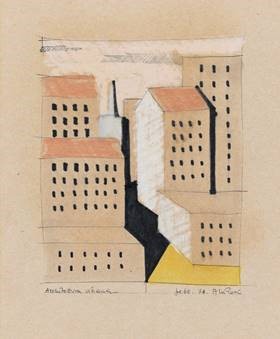
Aldo Rossi, one of the most important architectural theorists of the 20th century, had opposed modern building, which had emptied cities of their historical context and original function. He countered this with the idea of a rational architecture that kept the European city alive in the consciousness and sought to preserve its architectural history as an idea and as an orientation. Tradition was not to close itself off to the new, but to open up new paths for architecture through its inherent archetypal core.
At the same time Aldo Rossi was a highly important draughtsman. He created an extraordinarily diverse body of drawings that accompanied his theories as well as his building projects or was designed completely autonomously. The boundaries can become blurred; utopian ideas, the typological arsenal of the architect and concrete plans can merge. The project-related drawings also always have a great expressive quality. A particularly suggestive work is the “Architettura urbana”, in which, among other references, echoes of the pittura metafisica and, further back, of the city brochures of the Italian Renaissance can be found.
„The future of the art world is not digital. You can’t really understand most galleries without visiting their physical spaces.“
Marc Spiegler, Financial Times
This work by Aldo Rossi concludes the ” Image of the week ” series.
Galerie Dittmar
Auguststraße 22
10117 Berlin-Mitte
+49 30 280 985 40






